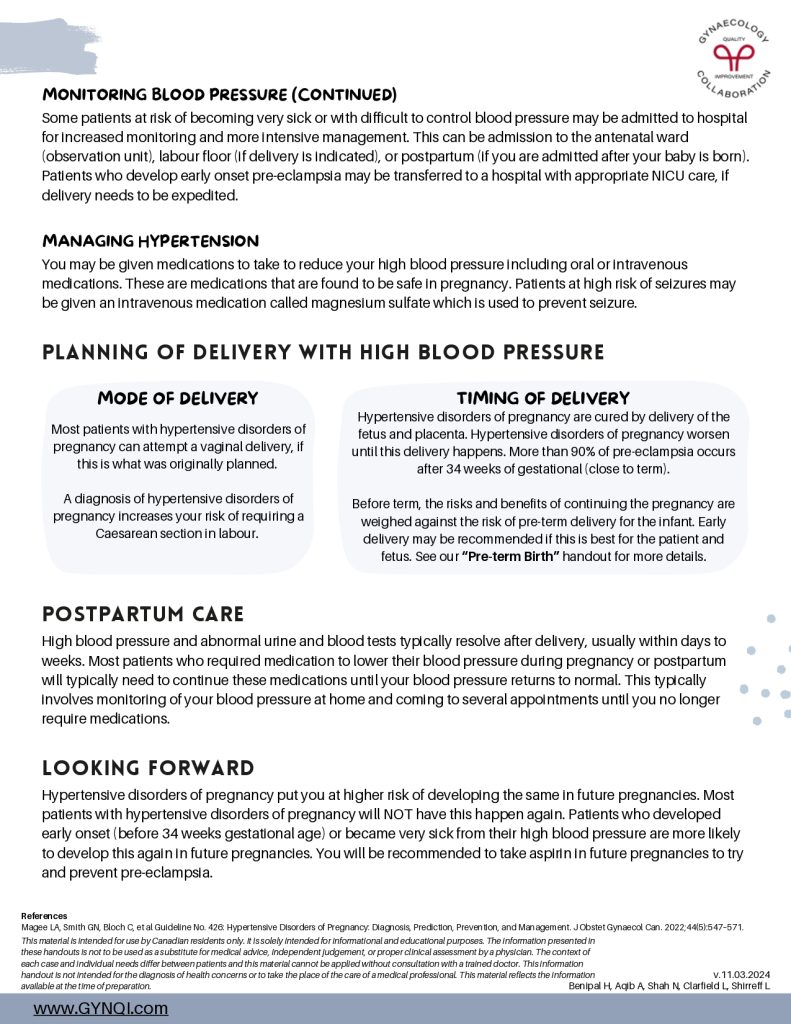
Hypertensive Disorders Of Pregnancy & Pre-eclampsia
Hypertension: Medical term used to refer to high blood pressure.
White Coat Hypertension: A term referring to high blood pressure that is elevated in a health care setting (e.g., doctor’s office or hospital) but is not found to be elevated with the patient leaves the clinical setting (e.g., when they take their own blood pressure at home).
Chronic Hypertension: Refers to someone with high blood pressure before pregnancy or who is diagnosed with a blood pressure disorder before 20 weeks gestational age.
Hypertensive Disorder of Pregnancy: This term is used to describe all high blood pressure-related disorders of pregnancy, including chronic hypertension, gestational hypertension, and pre-eclampsia.
Pre-eclampsia: New or worsening high blood pressure and signs and/or symptoms of end-organ dysfunction (e.g., issues with your kidneys, liver, blood or brain). It can also occur for the first time after delivery (postpartum pre-eclampsia).
Gestational Hypertension: This term is used to describe high blood pressure in pregnancy without evidence of end organ damage (i.e., normal blood tests and urine tests). Patients with gestational hypertension may develop pre-eclampsia over time.
Eclampsia: Eclampsia refers to when any hypertensive disorder of pregnancy progresses to a patient having seizures.
Signs or Symptoms of Pre-Eclampsia
- A headache that will not go away
- Blurry vision, seeing spots, or other changes in vision
- Severe nausea and vomiting during the 2nd half of pregnancy
- Shortness of breath or chest pain
- Swollen hands or face
- Sudden weight gain
- Severe shoulder or right upper abdominal pain
Please go to your OB triage if you develop any of these signs or symptoms!
Risk Factors For Pre-Eclampsia
Here are some risk factors for pre-eclampsia. Keep in mind – most pre-eclampsia develops in healthy patients with no risk factors!
- Multiple pregnancy (e.g., twins, triplets)
- Complications in previous pregnancies (e.g., low birth weight)
- Being pregnant for the first time
- Being pregnant ≥10 years after a previous pregnancy
- Previous pre-eclampsia or family history of preeclampsia
- In vitro fertilization (IVF)
- Body size (BMI >30)
- Age (≥35 years old)
- High blood pressure outside of pregnancy
- Kidney disease
- Pre-existing or gestational diabetes mellitus
- Autoimmune conditions (e.g., lupus) and blood clotting disorders
Can Pre-Eclampsia Be Prevented?
- Aspirin (ASA): daily low-dose aspirin started, ideally, between 12 and 16 weeks is recommended. This will be stopped at 36 weeks.
- Exercise: exercise is recommended to all pregnant people to prevent pre-eclampsia (unless there is a reason they cannot exercise).
- Calcium: calcium supplementation of at least 500mg per day is suggested for patients with low dietary intake of calcium to prevent pre-eclampsia.
How Is Pre-Eclampsia Diagnosed?
Your blood pressure is checked at every prenatal visit and/or if you develop new or worsening symptoms.
A hypertensive disorder of pregnancy is diagnosed when you have either 1 very high reading or several moderately elevated blood pressure readings on multiple occasions.
Pre-eclampsia is diagnosed with a combination of high blood pressure and abnormalities seen in your urine or on bloodwork.
* Systolic blood pressure (the top number): ≥140mmHg, and/or
* Diastolic blood pressure (the bottom number): ≥90mmHg
Why Treat Hypertensive Disorders of Pregnancy?
Hypertensive disorders of pregnancy can cause problems for the birthing parent and the baby. Risks include:
Birthing Parent
- Brain/Nervous System (e.g., seizures, blindness, stroke)
- Heart/Lung (e.g., heart attack, respiratory (lung) failure)
- Blood (e.g., low platelets, low red blood cells)
- Kidney (e.g., kidney failure)
- Liver (e.g., liver failure)
Baby
- Fetal growth restriction (small baby)
- Oligohydramnios (low fluid levels)
- Decreased blood flow through the umbilical cord
- Placental abruption (separation of the placenta from the uterus)
- Fetal heart rate changes
- Stillbirth
- Spontaneous or medically-indicated pre-term delivery
Management of High Blood Pressure Disorders of Pregnancy
We treat hypertensive disorders of pregnancy to limit complications for the birthing parent and baby and deliver the healthiest possible baby.
Monitoring the Pregnancy
Hypertensive disorders of pregnancy put the baby at higher risk of several complications. The health care team may recommend increased fetal monitoring (e.g., ultrasounds and fetal heart rate monitoring strips) to ensure the growth, heart rate and fluid around the baby are okay.
Monitoring Blood Pressure
Most patients with hypertensive disorders of pregnancy can be managed as an outpatient (i.e., you do not need to be admitted to hospital). You may be asked to get a blood pressure cuff for you to take your blood pressure at home. You will be given instructions on when and how to take this measurement and what to do with abnormal results.
Some patients at risk of becoming very sick or with difficult to control blood pressure may be admitted to hospital for increased monitoring and more intensive management. This can be admission to the antenatal ward (observation unit), labour floor (if delivery is indicated), or postpartum (if you are admitted after your baby is born). Patients who develop early onset pre-eclampsia may be transferred to a hospital with appropriate NICU care, if delivery needs to be expedited.
Managing Hypertension
You may be given medications to take to reduce your high blood pressure including oral or intravenous medications. These are medications that are found to be safe in pregnancy. Patients at high risk of seizures may be given an intravenous medication called magnesium sulfate which is used to prevent seizure.
Planning of Delivery With High Blood Pressure
Mode of Delivery
Most patients with hypertensive disorders of pregnancy can attempt a vaginal delivery, if this is what was originally planned. A diagnosis of hypertensive disorders of pregnancy increases your risk of requiring a Caesarean section in labour.
Timing of Delivery
Hypertensive disorders of pregnancy are cured by delivery of the fetus and placenta. Hypertensive disorders of pregnancy worsen until this delivery happens. More than 90% of pre-eclampsia occurs after 34 weeks of gestational (close to term).
Before term, the risks and benefits of continuing the pregnancy are weighed against the risk of pre-term delivery for the infant. Early delivery may be recommended if this is best for the patient and fetus. See our “Pre-term Birth” handout for more details.
Postpartum Care
High blood pressure and abnormal urine and blood tests typically resolve after delivery, usually within days to weeks. Most patients who required medication to lower their blood pressure during pregnancy or postpartum will typically need to continue these medications until your blood pressure returns to normal. This typically involves monitoring of your blood pressure at home and coming to several appointments until you no longer require medications.
Looking Forward
Hypertensive disorders of pregnancy put you at higher risk of developing the same in future pregnancies. Most patients with hypertensive disorders of pregnancy will NOT have this happen again. Patients who developed early onset (before 34 weeks gestational age) or became very sick from their high blood pressure are more likely to develop this again in future pregnancies. You will be recommended to take aspirin in future pregnancies to try and prevent pre-eclampsia.





